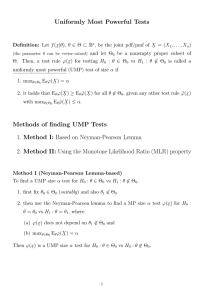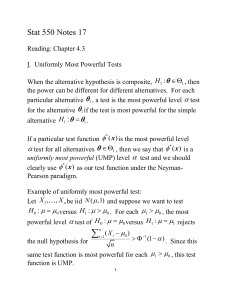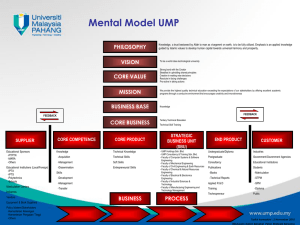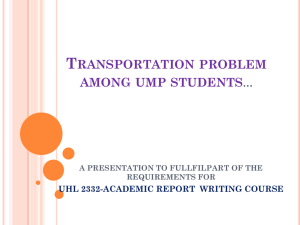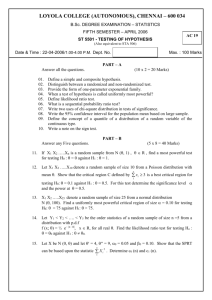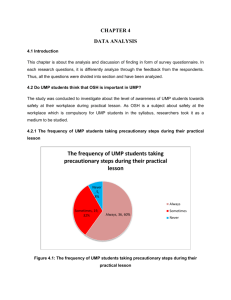Statistics 512 Notes 22: Wrap up of Sufficiency, Most Powerful Tests
advertisement
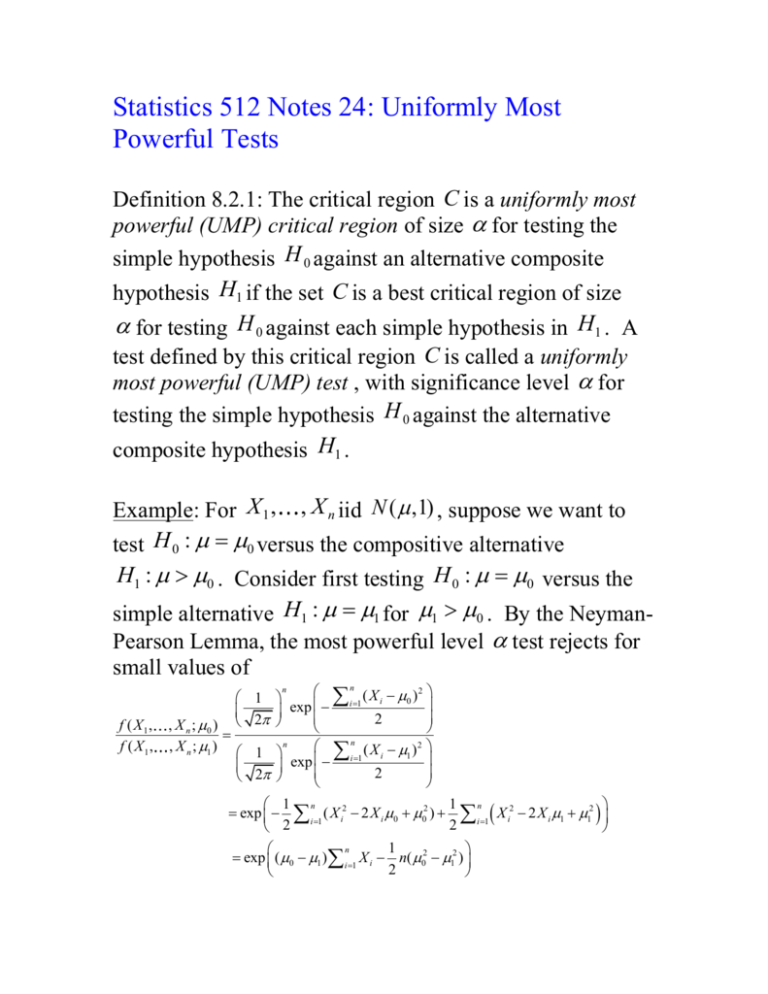
Statistics 512 Notes 24: Uniformly Most Powerful Tests Definition 8.2.1: The critical region C is a uniformly most powerful (UMP) critical region of size for testing the simple hypothesis H 0 against an alternative composite hypothesis H1 if the set C is a best critical region of size for testing H 0 against each simple hypothesis in H1 . A test defined by this critical region C is called a uniformly most powerful (UMP) test , with significance level for testing the simple hypothesis H 0 against the alternative composite hypothesis H1 . Example: For X 1 , , X n iid N ( ,1) , suppose we want to test H 0 : 0 versus the compositive alternative H1 : 0 . Consider first testing H 0 : 0 versus the simple alternative H1 : 1 for 1 0 . By the NeymanPearson Lemma, the most powerful level test rejects for small values of (X ) 1 exp n n i 1 f ( X1, f ( X1, 2 i 0 2 , X n ; 0 ) 2 , X n ; 1 ) 1 n n ( X i 1 ) 2 i 1 exp 2 2 1 n 1 n exp i 1 ( X i2 2 X i 0 02 ) i 1 X i2 2 X i 1 12 2 2 1 n exp ( 0 1 ) i 1 X i n( 02 12 ) 2 Because 1 0 , this is equivalent to rejecting for large values of n i 1 X i . Under H 0 : 0 , we have X i ~ N (n0 , n) . Thus, the most powerful level test Of H 0 : 0 versus the simple alternative H1 : 1 for n i 1 1 0 has critical region 1 X n n (1 ) i 0 i 1 n where is the standard normal CDF. Because the critical region of the most powerful test is the same for all simple alternatives H1 : 1 for 1 0 , the test with this 1 critical region ( i 1 X i n0 n (1 ) ) is the uniformly most powerful test for testing H 0 : 0 versus n the composite alternative H1 : 0 . Comment: The test with critical region 1 X n n (1 ) is also the uniformly most i 0 i 1 n powerful level test for testing H 0 : 0 versus the alternative H1 : 0 . Recall from Section 5.5 that the size of a test with a composite null hypothesis is max H 0 P X 1 , , X n C; . We have max 0 P 1 X n n (1 ); so that i 0 i 1 n the test with critical region X i n0 n1 (1 ) has size and is consequently the uniformly most powerful level test for testing H 0 : 0 versus the alternative H1 : 0 n i 1 Monotone Likelihood Ratios: Suppose X 1 , , X n iid f ( x; ) and we want to test H 0 : 0 versus the alternative H1 : 0 . When can we find a UMP test? Definition: We say that the likelihood L( ;( X1 , , X n )) has monotone likelihood ratio in the statistic Y u ( X1 , , X n ) if for 1 2 , the ratio L(1 ;( X 1 , , X n )) L( 2 ;( X 1 , , X n )) (*) is a monotone function of Y u ( X1 , , X n ) . Assume then that our likelihood function L( ;( X1 , , X n )) has monotone likelihood ratio in the statistic Y u ( X1 , , X n ) . Then the ratio in (*) is equal to g ( y ) where g is a decreasing function (the case where the likelihood function has a monotone increasing likelihood ratio follows similarly by changing the sense of the inequalities below). We claim that the following test is UMP level for testing H 0 : 0 versus the alternative H1 : 0 : Reject H 0 if Y cY , (**) where cY is determined by P(Y cY ;0 ) . ' Proof: First consider the simple null hypothesis H 0 : 0 . Let '' 0 be arbitrary but fixed. Let C denote the most ' powerful critical region for testing H 0 : 0 versus H1 : '' . By the Neyman-Pearson Theorem, C is defined by L(0 ;( X 1 , , X n )) k if and only if ( X 1 , , X n ) C , L( '';( X 1 , , X n )) where k is determined by P[( X1 , , X n ) C;0 ] . But by the definition of monotone likelihood ratio, because '' 0 , L( 0 ;( X 1 , , X n )) g (Y ) k Y g -1 (k ) , L( '';( X 1 , , X n )) 1 1 where g (k ) satisfies P[Y g (k ); ] ; i.e., cY g 1 (k ) . Hence, the Neyman-Pearson test is equivalent ' to (**). Furthermore, the test is UMP for H 0 : 0 versus H1 : 0 because we assumed only that '' 0 and the test is uniquely determined by 0 . Finally, to show that the test is UMP for H 0 : 0 versus H1 : 0 , we need to show that the test has size for testing H 0 : 0 , i.e., max P(Y g 1 (k ); ) . Consider testing H 0 : ''' versus H1 : 0 for ''' 0 using the critical region Reject H 0 if Y g 1 (k ) . 0 By the above argument, this test is the most powerful test 1 of level P(Y g (k ); ''') . By Corollary 8.1.1, the level of this most powerful test must be less than or equal to its power versus the alternative, i.e, P(Y g 1 (k ); ''') P(Y g 1 (k ); )) for ''' 0 . This proves that max 0 P(Y g 1 (k ); ) Example of monotone likelihood ratio: Let X 1 , , X n be iid with probability of success . Let ' '' . Consider the ratio of likelihoods n x n x xi L( '; x1 , , xn ) ( ') i (1 ') i '(1 '') 1 ' L( ''; x1 , , xn ) ( '') xi (1 '')n xi ''(1 ') 1 '' Since '/ '' 1 and (1 '') /(1 ') 1 so that '(1 '') / ''(1 ') 1 , the ratio is a decreasing function of y xi . Thus we have a monotone likelihood ratio in the statistic Y X i . Consider the hypotheses H 0 : ' versus H1 : ' . The UMP level decision rule for testing H 0 versus H1 is given by Reject H 0 if Y i 1 X i c , where c is such that P[Y c; '] assuming that such a c exists for the given level. n Other examples of families with monotone likelihood ratio: Family Y X Normal ( ,1) n i 1 i Poisson( ) n i 1 Xi Example of family that does not have monotone likelihood ratio: 1 1 f ( x ) Cauchy ( ) family: 1 ( x )2 . Two more examples where there is no UMP test: (1) Let X 1 , , X n be iid N ( ,1) . Suppose we want to test H 0 : 0 versus the alternative H1 : 0 . The most powerful test for alternatives ' 0 is to reject if 1 X n n (1 ) . The most powerful test for i1 i 0 alternatives ' 0 is to reject if n 1 X n n (1 ) . For ' 0 , the power i 0 i 1 n 1 of the test that rejects if i 1 X i n0 n (1 ) is greater than the power of the test that rejects if n 1 X n n (1 ) ; thus, there is no UMP test. i 0 i 1 n 2 (2) Let X 1 , , X n be iid N ( , ) . Suppose we want to test H 0 : 0 versus the alternative H1 : 0 . Here both the null hypothesis and the alternative hypothesis is composite (the null hypothesis is composite because can take on any positive value). There is no UMP test because the z-test for known is more powerful than the t-test for unknown . What to do when there is no UMP test? (1) Look for UMP unbiased test. A test is said to be unbiased if its power never falls below its significance level. By Corollary 8.1.1, the most powerful test of a simple null versus simple alternative is unbiased. For testing X 1 , , X n iid N ( ,1) , H 0 : 0 versus the alternative H1 : 0 , the test that rejects if 1 X n n (1 ) is not unbiased because it has i 0 i 1 n power for 0 . The UMP unbiased test rejects if n | i 1 X i n0 | n 1 (1 ) . 2 The t-test is UMP unbiased for testing X 1 , , X n iid N ( ,1) , H 0 : 0 versus the alternative H1 : 0 , 2 unknown. (2) Use Generalized Likelihood Ratio test. The generalized likelihood ratio test that we studied in Chapter 6 for testing H 0 : versus H1 : C generally has good power properties. The test rejects for small values of max L( ) Generalized Likelihood ratio: max L( ) (3) Use Decision Theory or Bayesian methods (rest of course).
